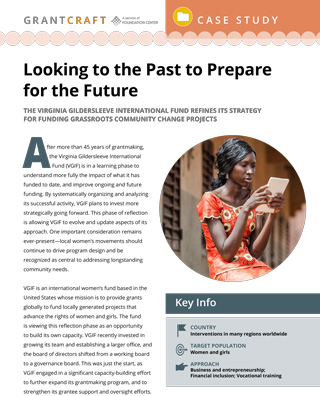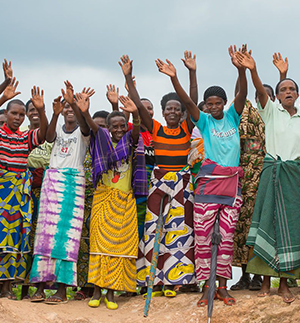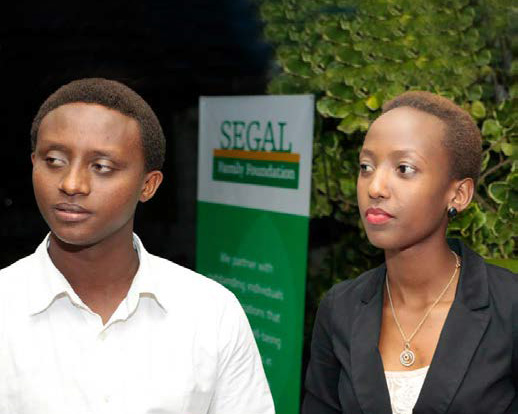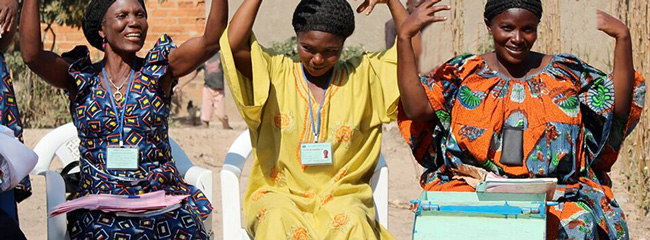Looking to the Past to Prepare for the Future VGIF Refines its Strategy for Funding Grassroots Community Change Projects
"VGIF's effort to build out more strategic components of staffing, the grants process, and partnership roles continues to rely on its core strategy, to let local experts design the projects," shares Kim Bylander, the Palmer fellow for monitoring and evaluation. Kim joined VGIF in 2013 during its expansion phase and is responsible for compiling and organizing all of VGIF’s granting data to help it learn from its investments to date. “The goal is to understand how projects we fund are operating, capture learning from the field, and help inform future funding decisions.”
VGIF has a rich history of funding women’s movements that are at the forefront of challenging issues and implementing programs with a holistic approach. Kim shares that a lot of VGIF’s funding goes to economic development projects, as access to livelihoods is what women most often identify as a need. Grantees will then build on the economic intervention to address other impending needs, including health, literacy, and conflict-resolution. For example, in 2013 in eastern Democratic Republic of Congo, VGIF funded a local, woman- led organization, Association of Volunteers for the Management of Vulnerable Children and Unaccompanied (AVEVENA), that was working to improve the economic and social status of young girl ex-combatants and girls affected by the conflict. Funds were used for sewing and business skills trainings, literacy education, and HIV/AIDS and reproductive health workshops.
While reviewing investment trends, Kim noticed that VGIF funded several women’s groups working in HIV/ AIDS across Sub-Saharan Africa in the 1990s. “Having worked in this field for many years, a women’s fund investing in HIV/AIDS programing struck me as very interesting because a lot of feminist organizations did not get involved until the 2000’s,” explains Kim. “It wasn’t seen as a heterosexual women’s issue in the 1990s; therefore, many donors did not prioritize funding it.” Women’s groups applying for VGIF grants were identifying HIV/AIDS as a growing need and wanted funding for programing to address this issue.
For Kim, this example reinforced the value and relevance of VGIF’s strategy, letting women’s movement and communities drive interventions. While it was always VGIF’s practice, this reflection builds even more intentionality into that mindset. VG has always felt that listening to local insight about what is impacting their communities is fundamental to its grantmaking as grassroots movements are deeply connected to their communities. To support local vision, VGIF has always provided very fluid and flexible funding. Now, the fund is learning how to build some structure into grants while still keeping funding unrestricted and allowing grantees to drive project intention and design. The goal is to help organizations think through their vision, and more specifically their strategy and action plan. VGIF provides one year, small-scale grants—up to $7,500 USD—to grassroots projects that are women-led. VGIF has recently introduced grants for multi-year projects. Organizations that have successfully completed a one-year grant are invited to apply and can receive funding for up to three years.
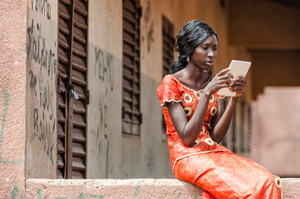 VGIF has revised its application and reporting materials to improve the application and grant selection process. In the current application, VGIF is asking applicants to more clearly list their strategies and to outline the ways in which community stakeholders have been and will be involved in all stages of the project. Through its revised application, VGIF is trying to push grantseekers to be more thoughtful in planning and explaining the steps they will use to achieve their intended goal. The additional questions about the community also give the applicants an opportunity to better tell their story and highlight the activism and engagement that brought them to the point of applying for a grant. The current application follows more of a logic model format, but has actually proven to be less cumbersome. “Despite asking for more details, the application is actually shorter now and more to the point. Applicants now tell us why they think a project is important, what they feel needs to change in their community, and list the specific steps that they are going to take to go towards that change.” Connecting a need with the project was an important step in clarifying efforts both for applicants and for foundation staff.
VGIF has revised its application and reporting materials to improve the application and grant selection process. In the current application, VGIF is asking applicants to more clearly list their strategies and to outline the ways in which community stakeholders have been and will be involved in all stages of the project. Through its revised application, VGIF is trying to push grantseekers to be more thoughtful in planning and explaining the steps they will use to achieve their intended goal. The additional questions about the community also give the applicants an opportunity to better tell their story and highlight the activism and engagement that brought them to the point of applying for a grant. The current application follows more of a logic model format, but has actually proven to be less cumbersome. “Despite asking for more details, the application is actually shorter now and more to the point. Applicants now tell us why they think a project is important, what they feel needs to change in their community, and list the specific steps that they are going to take to go towards that change.” Connecting a need with the project was an important step in clarifying efforts both for applicants and for foundation staff.
VGIF also adapted reporting materials to be more consistent and thoughtful about information collected. Through the revision process, VGIF wanted to focus on making reporting less cumbersome for grantees, create a structure that would elicit more robust data, and help the grantees to more clearly organize what they had learned. A review of VGIF’s 45 years of grantmaking revealed a range in the quality of past data, with many gaps in the types of information and data collected. Like other funds and social change organizations, VGIF is now moving towards more thoughtful data collection. This effort will help VGIF learn more about effective practice, share this learning with grantee and funding partners, and guide future investments. “We want to start learning more about the impact of projects at the community level, not just what activities were carried out. Evaluation data will help us start to catalogue what strategies are effective. We are also asking grantees to collect data and report on their reach more concretely. Our focus is not to become numbers driven, but to learn more about a strategy’s fit by looking at the numbers. For example, projects that are focused on community change through public awareness-raising require greater reach to be effective and the numbers should reflect that. Projects that are focused on skills-training or on working with women who experienced conflict-related assault and trauma should be tailored to smaller groups, so that should also come out in the data.”
With better data collection, more regular analysis, and better communication with grantees, VGIF hopes to identify effective strategies and add to the body of knowledge around women’s funding and development. The 2015 grant cycle will be the first to utilize the new application, monitoring, and reporting materials. Kim shares: “We didn’t experience a drop in applications; VGIF received over 1000 letters of inquiry for the 2015 grant cycle. Of these, 700 were invited to submit full applications and more than 450 applied. We found similarity in the number of applicants to previous years, but a tangible increase in the clarity and quality of projects.” VGIF funds between 35 and 40 one-year projects. Kim and the rest of the team are also eager to see the impact of the updated monitoring and reporting materials.
In this reflection and rebuilding period, VGIF will use past successes and challenges to build on investments that had clear impact. Improved data collection and communication will enable VGIF to become more strategic about where it invests resources going forward. Kim adds, “VGIF’s goal during this building phase is to organize information in a clearer, more accessible way so that staff, board members, and grantees can learn from it and take action. VGIF wants to see successes in the organizations and communities we fund, and so we are trying to learn and adjust our practices to better advance women’s development and rights through the investments we make."
This case study was developed for Foundation Center's Equal Footing project.
